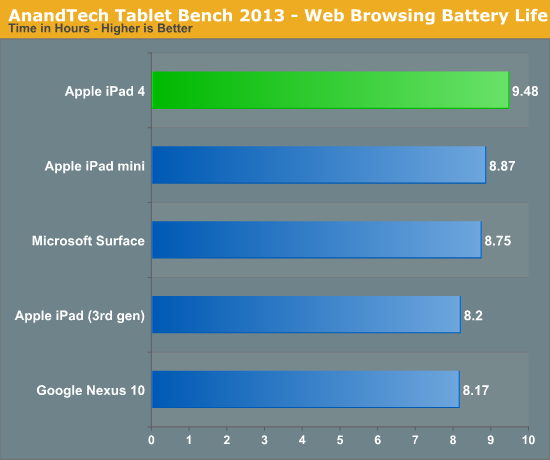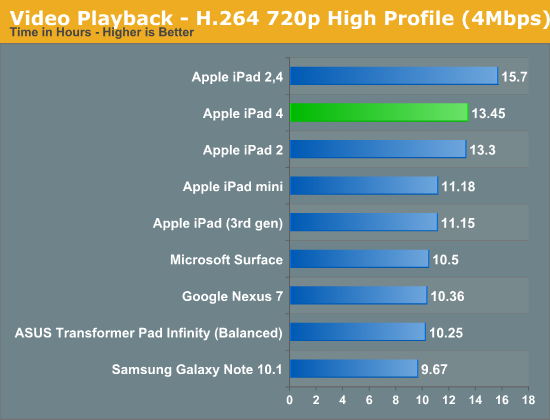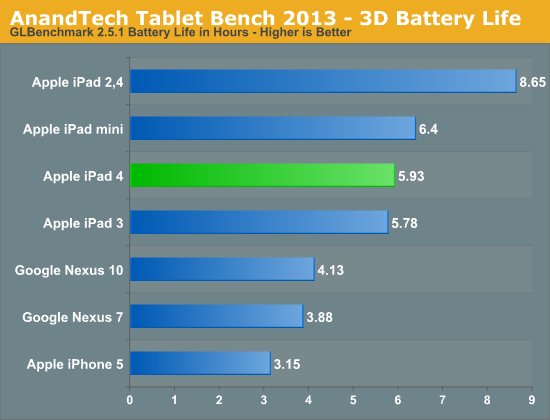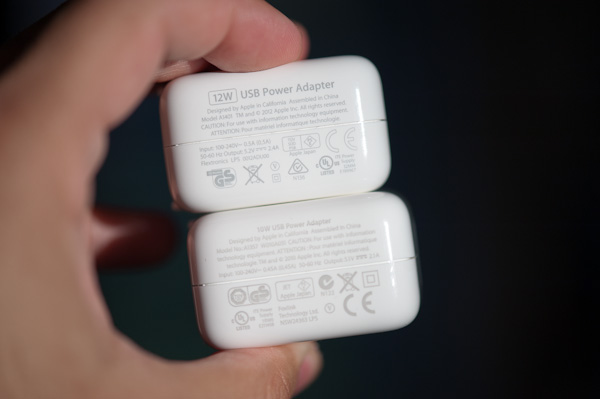iPad 4 (Late 2012) Review
by Anand Lal Shimpi on December 6, 2012 4:40 PM ESTCharging & Battery Life
The 4th gen iPad ships with a new 12W USB charger, a slight increase from the 10W model that shipped with all of the previous iPads. The new charger is no bigger than the previous version. Under max load the 12W charger will draw 13.57W at the wall. By comparison, the previous 10W model would pull a max of 12.44W. The 9% increase in power delivery does help shorten charge times a bit as it now only takes 5.69 hours for a complete charge (compared to ~6 with the old charger). It still takes a really long time to complete a full charge on the iPad, but without going to a larger power brick (or reducing the iPad's battery capacity) I don't see a simple solution here.

The iPad 4 is able to maintain charge equilibrium in the cases I tested, even under heavy load. With the 3rd generation iPad, if I ran Infinity Blade 2 while plugged in the total available battery charge would drop over time. On the 4th gen iPad, that no longer happens. I was able to maintain charge equilibrium even with the old 10W adapter on the iPad 4, pointing at overall power efficiency improvements rather than the new 12W adapter as the explanation for why this is now possible. It is possible that with fully loaded CPU and GPU cores that the new model wouldn't be able to maintain charge while powering the device, however I haven't encountered such a scenario yet.
Charge time isn't the only thing that improves with the 4th generation iPad. When Apple introduced the iPad 3, we saw a clear regression in battery life despite the much larger battery. I hate to sound like a broken record, but it's that same combination of power hungry display and big SoC that were responsible for the iPad 3's lower battery life. The iPad 4 doesn't ditch the display, but it does move to a 32nm LP HK+MG process for the SoC. Max power consumption should be higher thanks to the faster CPU/GPU cores, but given the same workload we should see a tangible improvement in battery life (similar to what we saw with the iPhone 5). We went through our standard suite of battery life tests to find out how things have changed since the iPad 3.
We've started running our new smartphone web browsing battery life test on tablets as well. If you missed its introduction in our iPhone 5 review, here's a bit about the new test:
We regularly load web pages at a fixed interval until the battery dies (all displays are calibrated to 200 nits as always). The differences between this test and our previous one boil down to the amount of network activity and CPU load.
On the network side, we've done a lot more to prevent aggressive browser caching of our web pages. Some caching is important otherwise you end up with a baseband/WiFi test, but it's clear what we had previously wasn't working. Brian made sure that despite the increased network load, the baseband/WiFi still have the opportunity to enter their idle states during the course of the benchmark.
We also increased CPU workload along two vectors: we decreased pause time between web page loads and we shifted to full desktop web pages, some of which are very js heavy. The end result is a CPU usage profile that mimics constant, heavy usage beyond just web browsing. Everything you do on your device ends up causing CPU usage peaks - opening applications, navigating around the OS and of course using apps themselves. Our 5th generation web browsing battery life test should map well to more types of mobile usage, not just idle content consumption of data from web pages.

I no longer have a 45nm iPad 2 so forgive me for the incomplete dataset here (it's safe to say that the iPad 2 would at least equal the iPad 4 in battery life, if not exceed it), but battery life has improved appreciably since earlier this year. The iPad 4 lasts around 15% longer on a single charge compared to the 3rd gen iPad. It also edges out the iPad mini and Microsoft's Surface. There's a good advantage over the Nexus 10 as well, but all of these tablets have smaller batteries than the iPad 4..
We haven't yet rerun our new test on all of the tablets, so we turn to our older 4th gen test to provide some additional reference points:

Here we see that although Apple has improved things, the iPad 4 still remains behind the old iPad 2's battery life target. Also note that in a lighter CPU workload where the iPad 4's Swift cores aren't asleep for substantially longer than the iPad 3's Cortex A9s, the difference in battery life ends up being pretty minimal.
Our video playback test remains unchanged from previous tablet reviews. Here I'm playing a 4Mbps H.264 High Profile 720p rip I made of the Harry Potter 8 Blu-ray. The full movie plays through and is looped until the battery dies. Once again, the displays are calibrated to 200 nits:

Video playback battery life has finally surpassed that of the iPad 2. As we saw with our camera analysis, Apple did some work on the video encode hardware/software this generation - it's also possible that the decode path saw an improvement as well. The 32nm iPad 2,4 still remains the king of this test but that's a bit of an anomaly. It's rare that we see a pure die shrink with no added performance/features offered these days.
Our final cross-platform battery life test is the new GLBenchmark 2.5.1 Egypt HD test. Here we have a loop of the Egypt HD benchmark, capped to 30 fps, running on all of the devices with their screens calibrated to 200 nits.

The results here actually surprised me a bit, but they make sense when you think about them. Capped at 30 fps (like many heavy iOS games are) the 4th generation iPad actually has GPU performance to spare in the Egypt HD test (avg frame rate is 40 fps vs. 21 fps for the iPad 3). Despite the fact that the 4th gen iPad has a more power hungry GPU, that extra performance remains partially unused which, when combined with the more power efficient 32nm LP process, gives the new iPad a slight edge in gaming battery life. Note that this only applies to the situation where the workload is identical between the iPad 3 and 4. Earlier I showed that some games actually put the increased shader power to good use and increase image quality. In these cases where the iPad 4 is doing more physical work than the iPad 3, you may see no improvement in battery life or even a regression.
Thermals
The display and backlight in the 3rd generation iPad, combined with the large 45nm SoC, resulted in a tablet that got pretty warm under load. The 4th gen model doesn't do away with the display but it does move to silicon that can drive to low power sleep states quicker than before (given the same workload). The result is a tablet that has the potential to run a bit cooler depending on what you're doing with it.
Under full load however there's no getting around the fact that both the CPU and GPU cores are significantly faster than their predecessor. Running Infinity Blade 2 for an hour produced slightly higher surface temperatures on the iPad 4 vs. the iPad 3:
| Thermal Comparison - iPad 3 vs. 4 - Infinity Blade 2 Loop (1hr) | ||||
| Temperature Measurement Location | Apple iPad 4 | Apple iPad 3 | ||
| Back of Tablet, Apple Logo | 35.7C | 34.4C | ||
| Back of Tablet, Hottest Point | 39.9C | 39.1C | ||
The difference isn't huge and it's only noticeable if you switch between the two tablets, but there's no real improvement in worst case thermals. The iPad 4 remains one of the warmest tablets that I've used. It doesn't get uncomfortably hot but I would prefer a cooler running device. Unfortunately until we see a big improvement in display power consumption, I just don't know how that will be possible. The move to 20nm won't happen anytime soon.











113 Comments
View All Comments
s44 - Thursday, December 6, 2012 - link
First pixel density is everything, now color calibration... Coincidentally when Apple starts promoting their selling point.zanon - Thursday, December 6, 2012 - link
None of this is new stuff kid. Pixel density has been something that a lot of us have wanted for a long time, it just somehow never was a priority for anyone. I can easily remember being awed by the IBM T220 (a 22" 3840×2400 [WQUXGA] screen) back in 2001. It used multiple dual link DVI, and the launch price was around $18k, dropping to around $8.5k a year or two later. I hoped back then that it would rapidly proliferate and descend at least to the mere "high end" level, rather then "stratospheric", but it was not to be. Similarly, color has also always mattered for a lot of us. I'm sitting in front of an NEC display built with that in mind, but there has been a whole market of higher end displays and calibration hardware since practically the dawn of color.Just because it's only now that, at long last, the industry is moving out of its previous equilibrium doesn't mean there's some conspiracy or "moving targets" or whatever other stupid BS you think of. It would have been nice to see this getting pushed harder and wider literally 10 years ago. Better late then never though. Excellent color and density should be the standard, not the exception, and I'm delighted to see everything suddenly leaping forward again. Density came first, as the most obvious, lowest hanging fruit. Color is next, first with tighter filters, hopefully next year with IGZO and quantum dot films. 120 Hz becoming standard everywhere would be nice too. Whoever helps make that happen gets a hearty thanks from me, even if I never buy any of their stuff directly.
Sabresiberian - Friday, December 7, 2012 - link
You are so right here! The introduction of the LCD set us back at least a decade, in terms of color quality, refresh rate, and pixel density.I'm not a great fan of Apple the company, but some things they do right, and do better than the PC industry. Displays in portable devices is one of those things. I'm not in the market for anyone's tablet, but I am tempted by the Retina Display notebooks.
PC portable computer manufacturers take notice: even a somewhat anti-Apple person is considering buying Apple over your junk displays. Time for you to step up your game!
Arbee - Friday, December 7, 2012 - link
I would kill for a 20" or 25" 4:3 LCD panel with something like 2048x1536 resolution on a good quality IPS panel with decent color fidelity.Heck, at this point I'd like to see any new LCD display that's 4:3 other than what's in the iPad. 4:3 is still preferable for a lot of actual work on computers (programming, word processing, spreadsheets, etc) but the industry decided unilaterally we were all just content consumers and we need a screen optimized only for movies.
tim851 - Saturday, December 8, 2012 - link
This is the "logic" of the anti 16:x crowd that I don't get.So you would kill for a 25" 4:3 panel with 2048x1536 pixels.
Why?
You are aware that a 30" 16:10 panel with 2560x1600px is
1) physically higher by almost an inch
2) has 64 more vertical pixels
Why the dislike for an extra 512 horizontal pixels?
Also, if you are willing to accept a 20" 4:3 screen: a 27" 2560x1440 screen that sells from 300$ on ebay is also physically higher (by more than 1 inch) and only has 94 viewer vertical pixels (6%)...
londiste - Saturday, December 8, 2012 - link
who said anything about dislike for horizontal pixels? it is dislike for lack of vertical pixels.anandtech site we're on fits just fine into half of my 1920 horizontal pixels, but the 120 extra vertical pixels that my 1920x1200 screen has over 1080p are extremely useful.
tim851 - Saturday, December 8, 2012 - link
The guy I responded to would "kill" for a display with 2048x1536 pixels.I wonder why, when he could have bought a display with 2560x1600 years ago.
That is MORE VERTICAL PIXELS and MORE PHYSICAL SCREEN HEIGHT.
Also, Anandtech is a very vertical site, I don't see how 120 extra pixels is helping you much there. Is scrolling 10 screens down instead of 9 really bothering you?
I use Firefox with the tree-style tab addon which puts the tabs in the sidebar, freeing up vertical space and practically using horizontal space. A lot of applications these days are optimized to use horizontal space.
Had a 21" 4:3 CRT until three years ago and let me tell you I gladly accepted a 16:9 24" LCD.
I for one prefer using two 'shallow' windows side-by-side instead of once very deep window.
Olaf van der Spek - Saturday, December 8, 2012 - link
1600p being 5x as expensive as 1080p is the real problem.Yes, more vertical pixels really matter in some cases. It's a bit like running out of memory and having to use swap, it's much slower.
Arbee - Monday, December 10, 2012 - link
I don't dislike the extra horizontal pixels, I just want more vertical pixels to go with it. I am a programmer; it is a *substantial* productivity boost to be able to see an entire function on the screen at once. Seeing more width is comparably of very limited benefit.And a $300 27" anything is unlikely to have a good-quality panel in it. I am so done with screens that go purple if you don't keep your head perfectly still (that on a $1800 Toshiba laptop) or have a weird tint to them that you can't get rid of.
xyzzy1 - Wednesday, December 12, 2012 - link
Much like Digital/CD set back musical reproduction. Digital is still trying exceed what top end analugue playback achieved! Off topic but couold not resist....